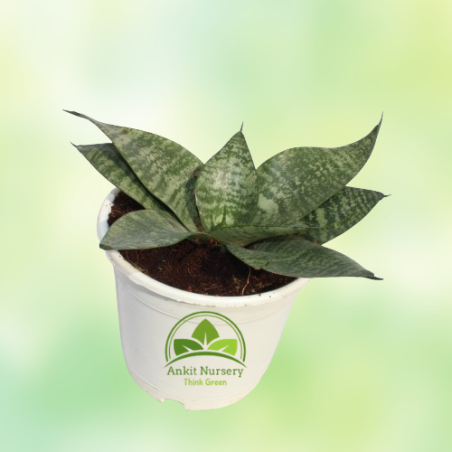
- -10%






The Dwarf Snake Plant, scientifically known as Sansevieria trifasciata, is a compact variety of the popular Snake Plant. The Dwarf Snake Plant features stiff, upright leaves with green and yellow variegation. The leaves grow in rosettes and can reach heights of about 6 to 12 inches, making it a smaller and more compact option compared to other Snake Plant varieties.
They can thrive even in low-light environments, but they grow best with moderate to bright indirect light. Avoid placing them in direct sunlight, as it can scorch the leaves. Allow the soil to dry out partially between waterings. Water your Dwarf Snake Plant thoroughly, but be sure to let excess water drain away to prevent waterlogged soil, which can lead to root rot. In winter, reduce watering frequency.
Use a well-draining potting mix designed for succulents or cacti. A mix containing perlite or sand helps prevent water retention and promotes healthy root growth. Dwarf Snake Plants prefer temperatures between 60-85°F (15-29°C). They are tolerant of a wide range of temperatures but should be protected from cold drafts. These plants can tolerate low humidity levels, making them suitable for various indoor environments. However, they may benefit from occasional misting or grouping with other plants to increase humidity. Dwarf Snake Plants tolerate a wide range of light conditions, from low to bright indirect light.
Fertilize your Dwarf Snake Plant sparingly during the growing season (spring and summer) with a balanced houseplant fertilizer diluted to half strength. Avoid fertilizing in fall and winter when growth slows down. Dwarf Snake Plants can be propagated through division or leaf cuttings. Division involves separating offsets or pups from the main plant and replanting them in separate pots. Leaf cuttings can be taken from healthy leaves and placed in moist soil to root.
Remove any dead or yellowing leaves as needed to maintain the plant's appearance. Pruning can also help control the size and shape of the plant. Like other Snake Plant varieties, Dwarf Snake Plants are considered mildly toxic if ingested. Keep them out of reach of children and pets. Overall, Dwarf Snake Plants are low-maintenance and resilient houseplants, making them an excellent choice for beginners or anyone looking to add greenery to their indoor space. With proper care, they can thrive and bring beauty to any room.
The term "Golden Fern Plant" isn't a specific botanical name, but it could refer to a few...
Thalia dealbata, commonly known as the Hardy Water Canna. Thalia dealbata is known for its...
"Chlorophytum" plant, commonly known as the Spider Plant. Chlorophytum comosum, or Spider...
Ferns are a diverse group of plants known for their delicate, feathery foliage and are...
The term "Syngonium Golden" likely refers to a variety of Syngonium plant with golden or...
Indoor plants are a great way to bring nature into your home, purify the air, and enhance your...
The Money Plant, also known as Pilea peperomioides, is a popular houseplant known for its...
Aglaonema, commonly known as Chinese evergreen, is a popular indoor plant appreciated for its...
Araucaria is a genus of evergreen coniferous trees and shrubs native to the Southern...
The Spider Plant (Chlorophytum comosum) is a popular and easy-to-grow houseplant known for its...
The Green Aglaonema, scientifically known as Aglaonema commutatum, is a popular and...
Rubber Plant - White Pot is a popular and attractive houseplant known for its glossy, deep...
A water plant, also known as an aquatic plant or hydrophyte, is a type of plant that has...
The "Song of India" plant is a common name for the Dracaena reflexa var. angustifolia, a...
Radermachera Plant also known as China Doll or Emerald Tree, is a genus of tropical flowering...
Red Sensation Cordyline, also known as Cordyline fruticosa 'Red Sensation' or Red Sensation...